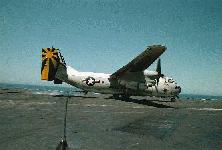
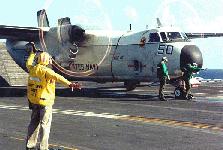
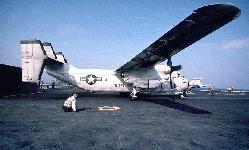
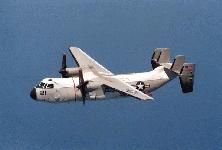
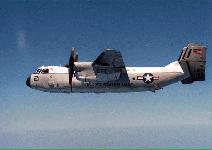
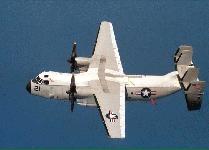



Priority cargo such as jet engines can be transported from shore to ship in a matter of hours. A cage system or transport stand provides cargo restraint for loads during carrier launch or landing. The large aft cargo ramp and door and a powered winch allow straight-in rear cargo loading and downloading for fast turnaround.
The C-2A's open-ramp flight capability allows airdrop of supplies and personnel from a carrier-launched aircraft. This, plus its folding wings and an on-board auxiliary power unit for engine starting and
ground power self-sufficiency in remote areas provide an operational versatility found in no other cargo aircraft.
The C-2A has a wide range of communications and radio navigation equipment that is compatible with both military and civil airways on a worldwide basis. Communications equipment includes HF, VHF, and UHF; radio navigation aids include GPS, OMEGA, TACAN, dual VOR, UHF/DF, LF/ADF, weather radar, Doppler radar, and two carrier approach systems. The crew consists of a Pilot, Copilot, Crewchief, and Loadmaster / Second Crewman.
The original C-2A aircraft were overhauled, and their operational life extended, in 1973. In 1984, a contract was awarded for 39 new C-2A aircraft to replace earlier the airframes. Dubbed the Reprocured C-2A due to the similarity to the original, the new aircraft include substantial improvements in airframe and avionic systems. All the older C-2As were phased out in 1987, and the last of the new models was delivered in 1990. The C-2A(R) retains the characteristics of the E-2C Aircraft in the areas of structures, hydraulics, and power plants. The avionics block upgrades for the C-2A(R) provide increased reliability and maintainability. A limited development test was conducted on the C-2A(R), due to the minor differences to the previous C-2A. Development Test and Evaluation (DT&E) and Operational Test and Evaluation (OT&E) were previously completed on the original C-2A Production Acceptance Test and Evaluation on the C-2A(R) was performed by the Naval Air Warfare Center Aircraft Division (NAWCAD), Patuxent River, Maryland, from June 1985 to February 1986. The C-2A(R) provides tactical logistics support for deployed carrier battle groups. These aircraft have a 10,000 pound payload capacity and operate from forward area air stations in support of Atlantic and Pacific fleet operations. The aircraft's large aft door-ramp and powered winch promote a fast turnaround time via straight-in rear loading and unloading. Special missions have been developed which employ the C-2A. These missions include personnel, Combat Rubber Raiding Craft (CRRC), and air cargo drops. The CRRC drops entail disembarking a team of divers and their equipment while airborne. During the period November 1985 to February 1987, VR-24, operating with seven Reprocured C-2As, demonstrated exceptional operational readiness while delivering two million pounds of cargo, two million pounds of mail and 14,000 passengers in support of the European and Mediterranean theatres.C-2A Greyhounds with upgraded communications, navigation, instrumentation packages, and a Critical Service Life Extension Program (SLEP) will provide cost-effective, carrier-on-board delivery for the next 20 years.
Specifications | |
| Primary Function | Carrier-on-board delivery (COD) aircraft |
| Contractor | Grumann Aerospace Corp. |
| Unit Cost | $38.96 million |
| Propulsion | Two Allison T-56-A-425 turboprop engines; 4,600 shaft horsepower each |
| Length | 57 feet 7 inches (17.3 meters) |
| Height | 17 feet (5 meters) |
| Weight | Max. gross, take-off: 57,000 lbs (25,650 kg) |
| Cruising Speed | Max.: 300 knots (345 miles, 553 km, per hour) |
| Ceiling | 30,000 feet (9,100 meters) |
| Range | 1,300 nautical miles (1,495 statute miles) |
| Crew | Four |





